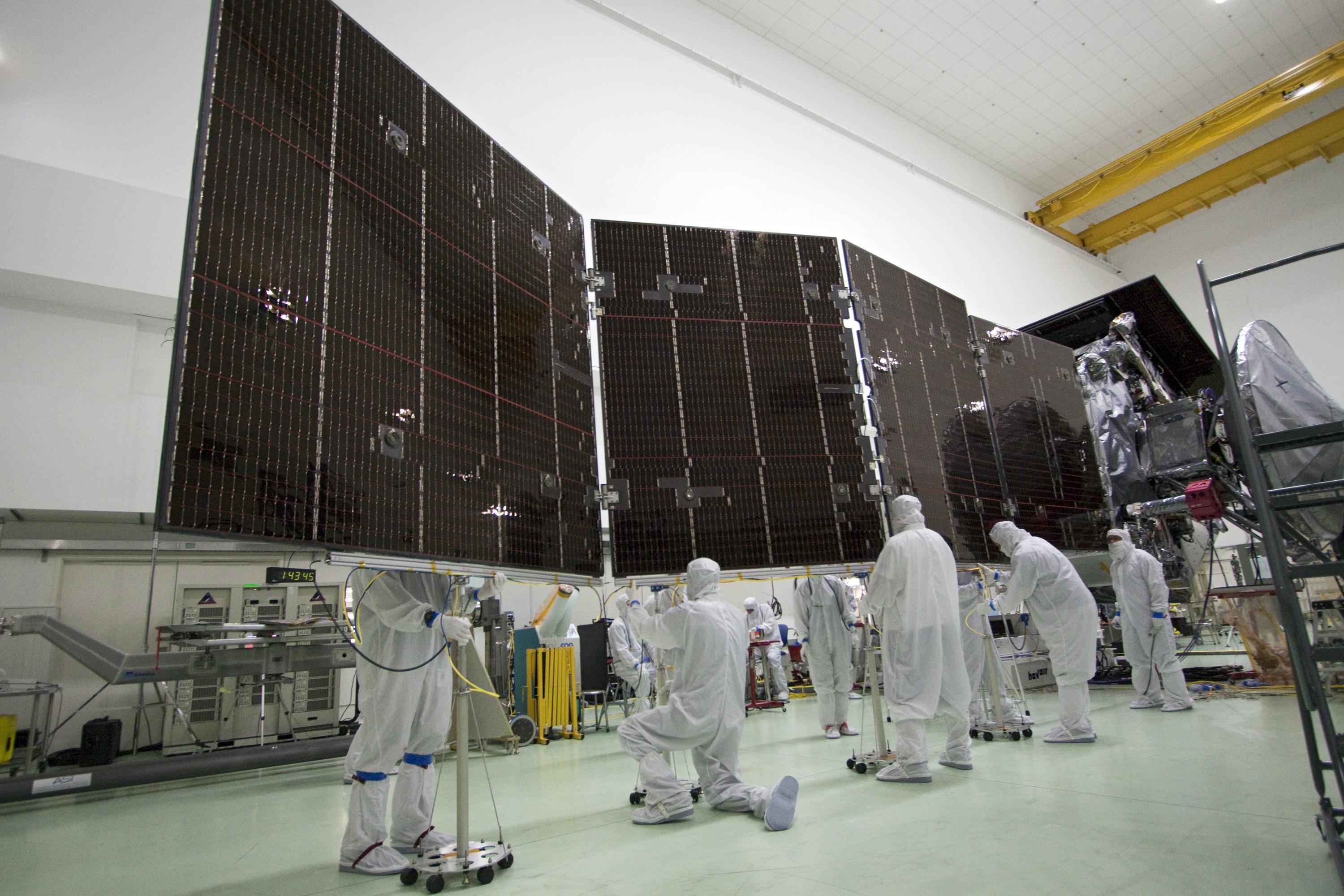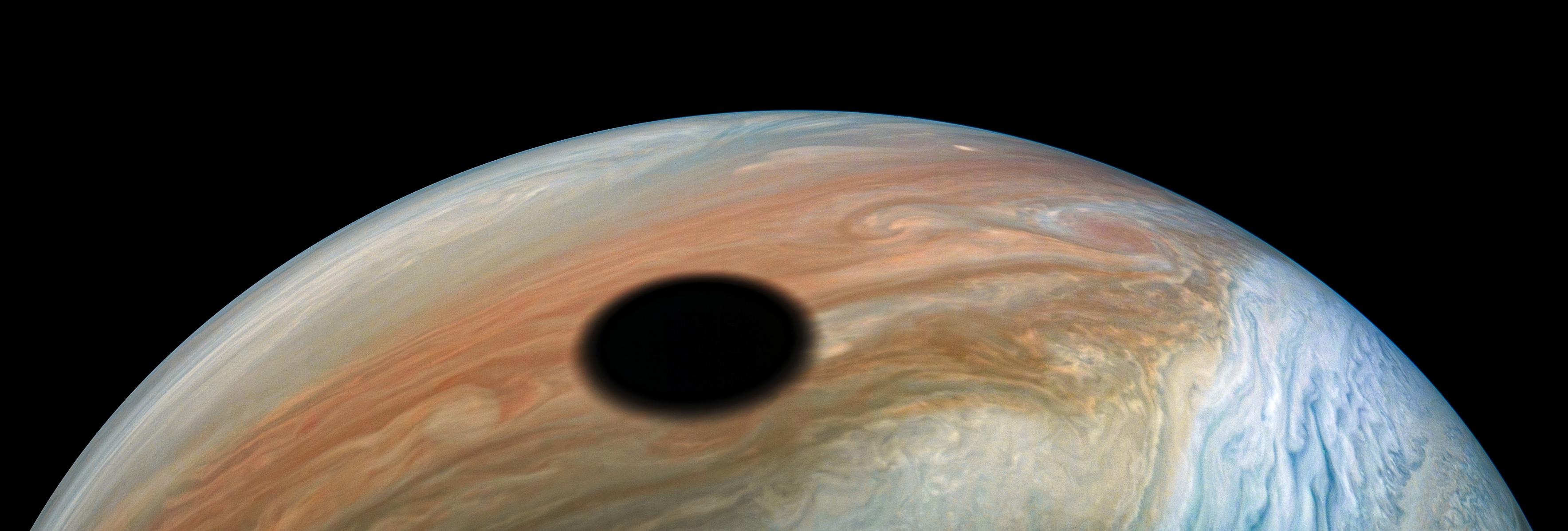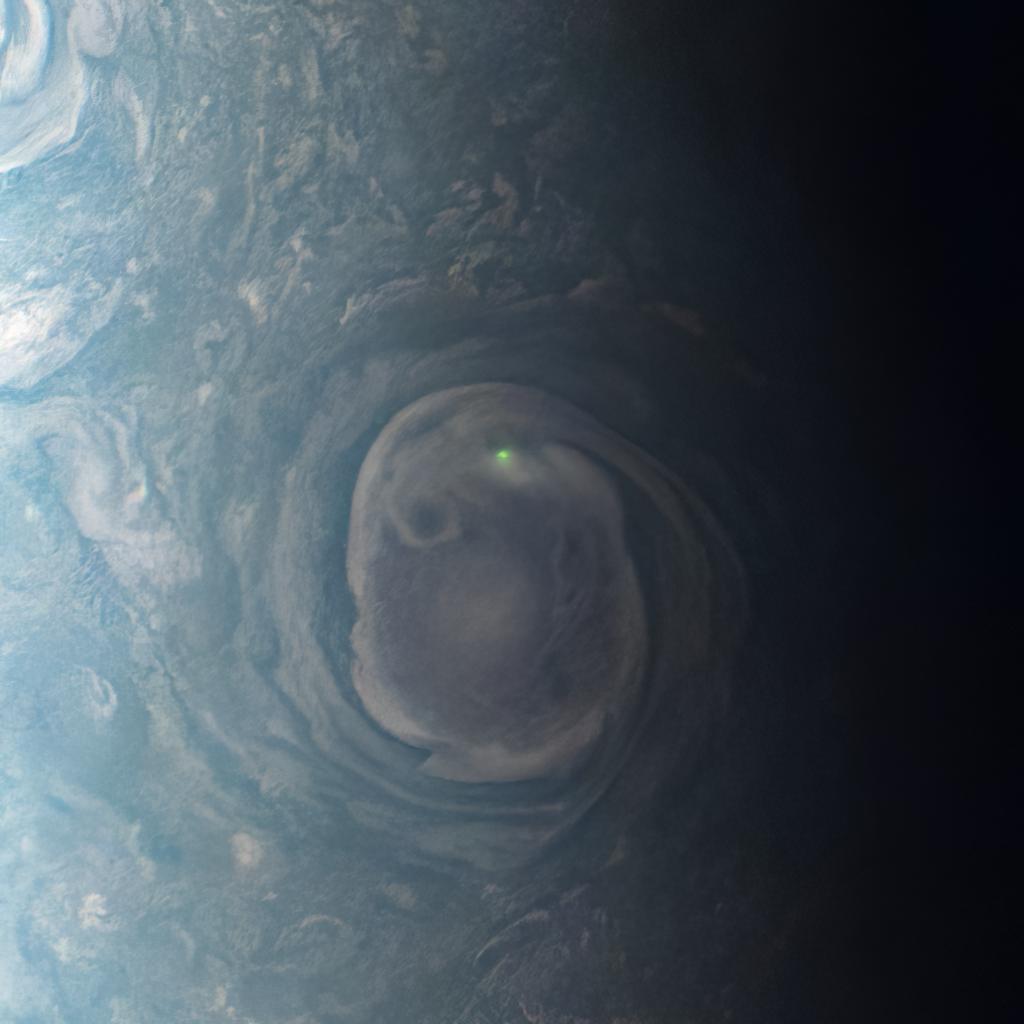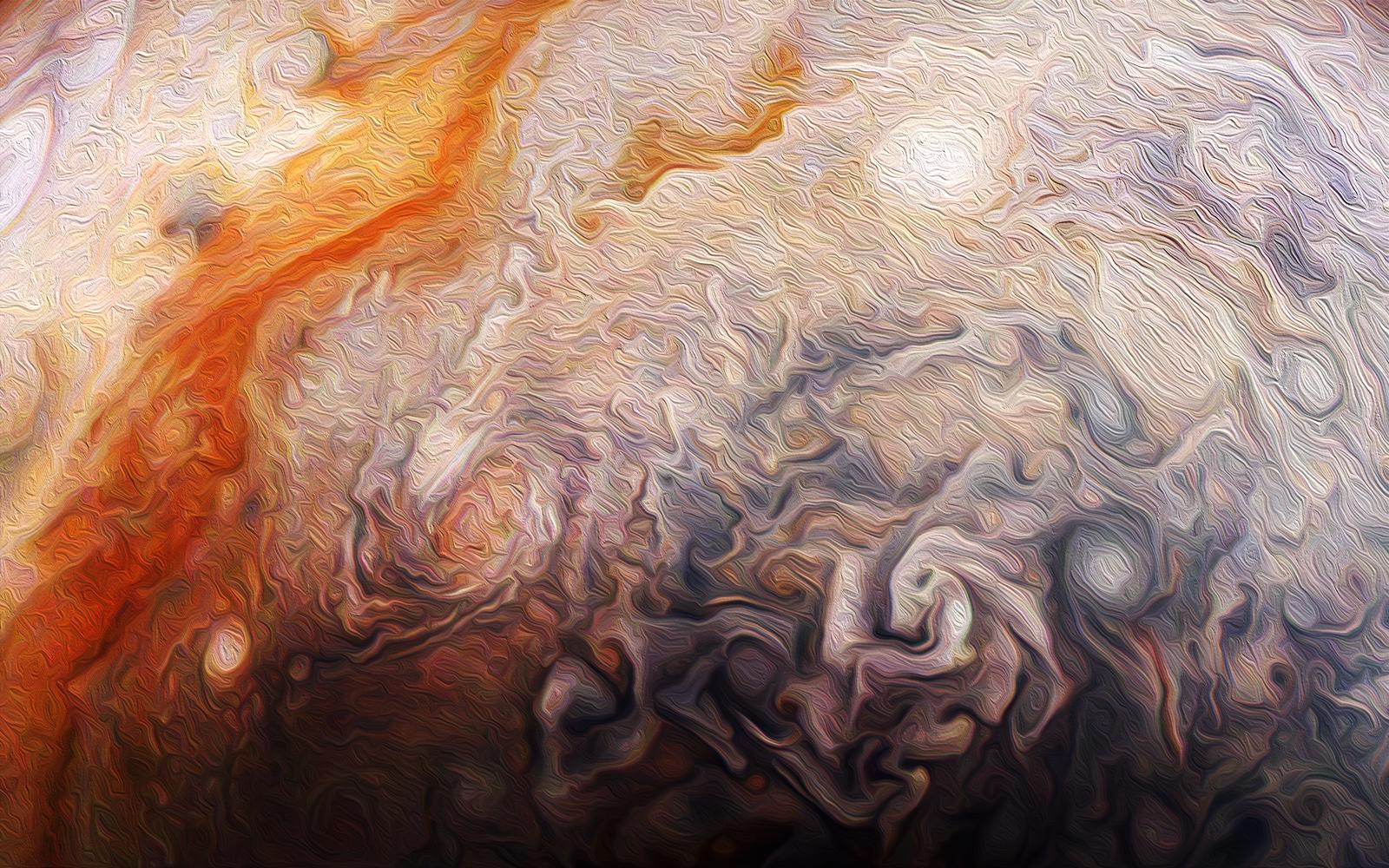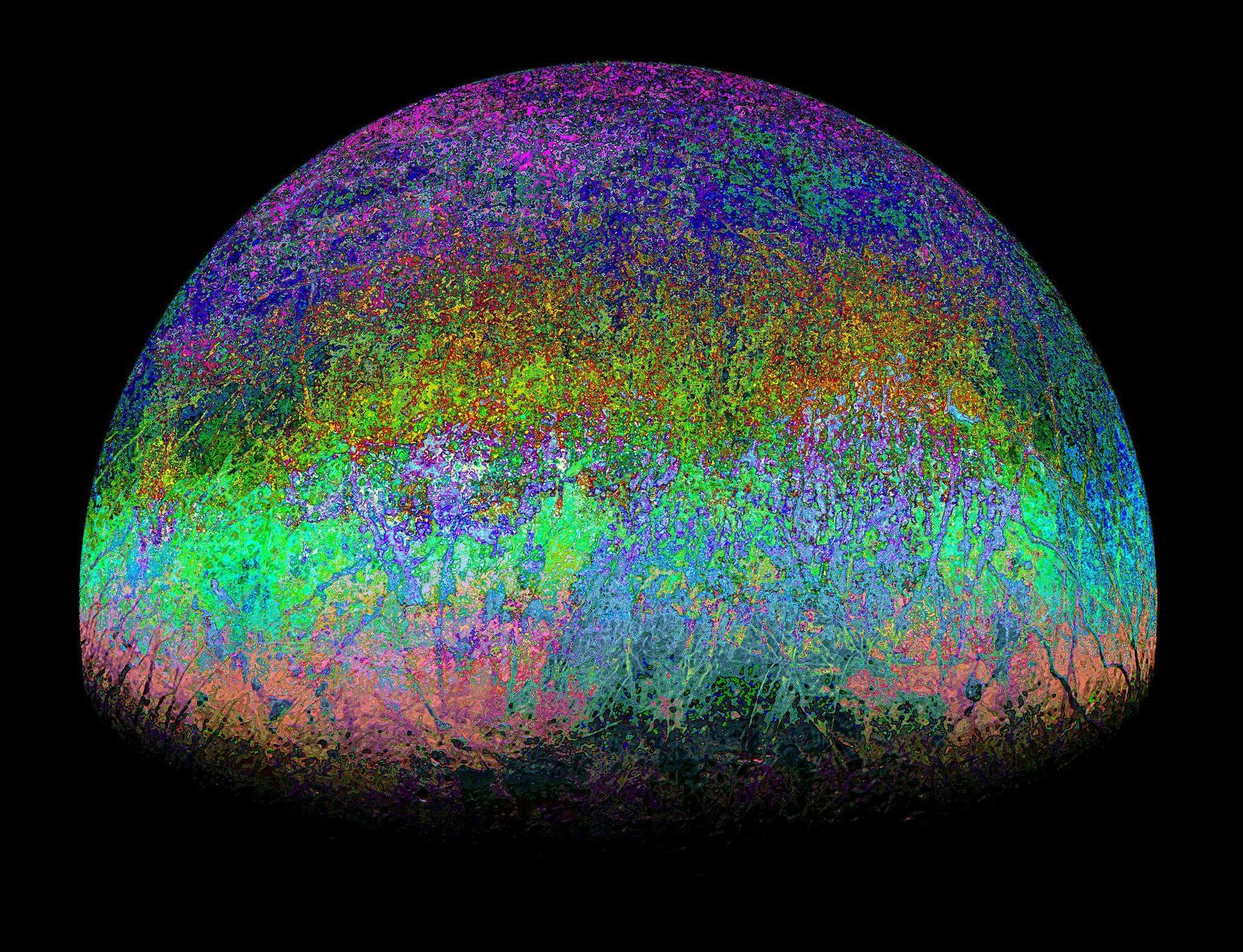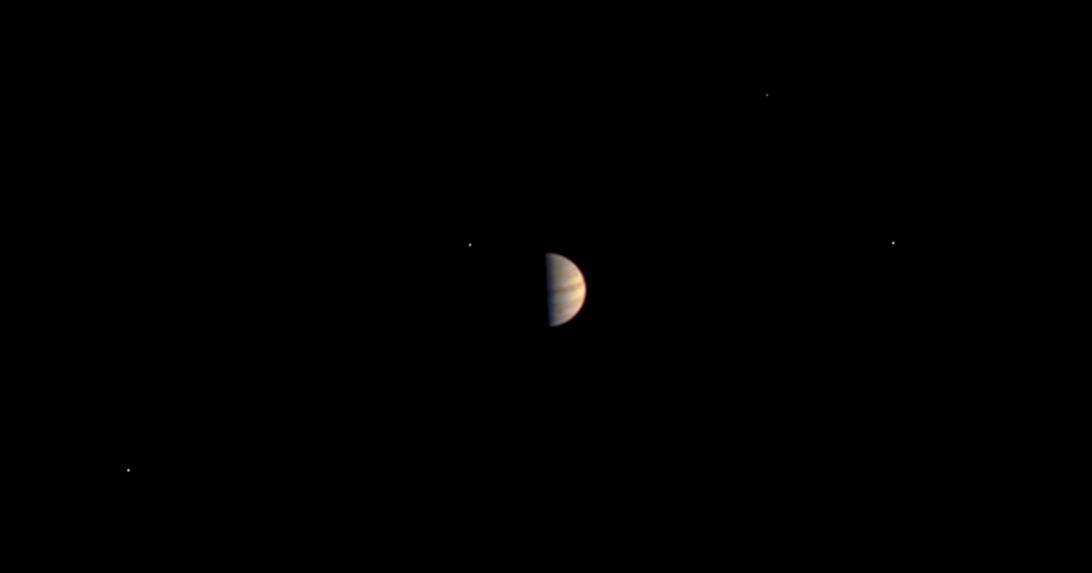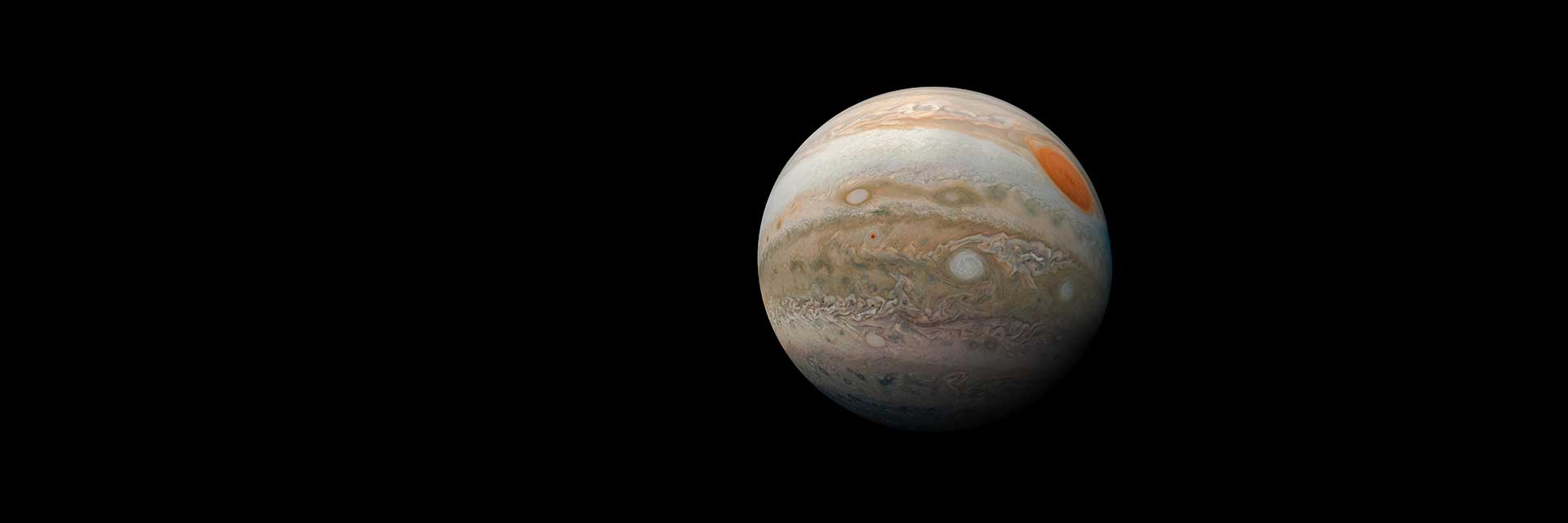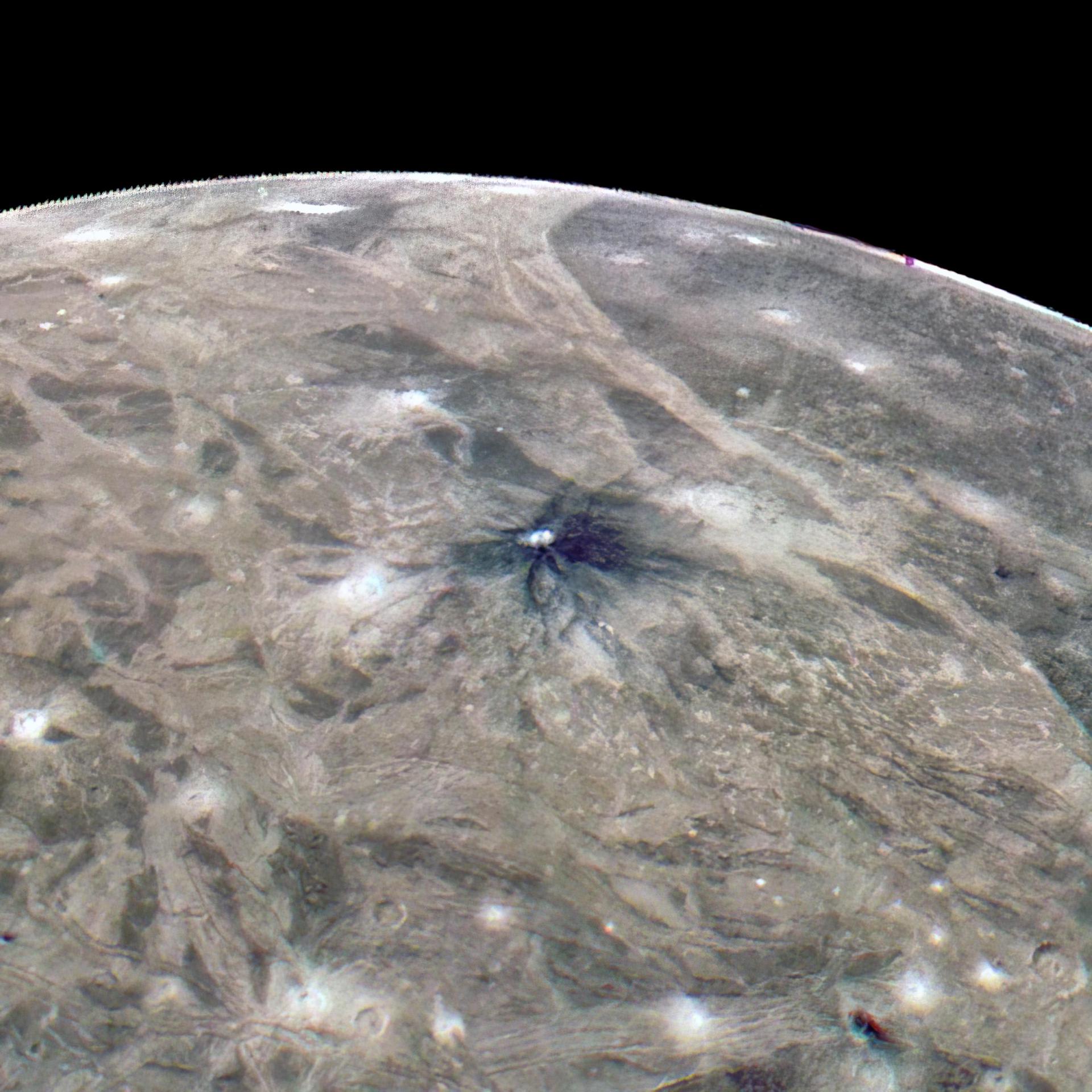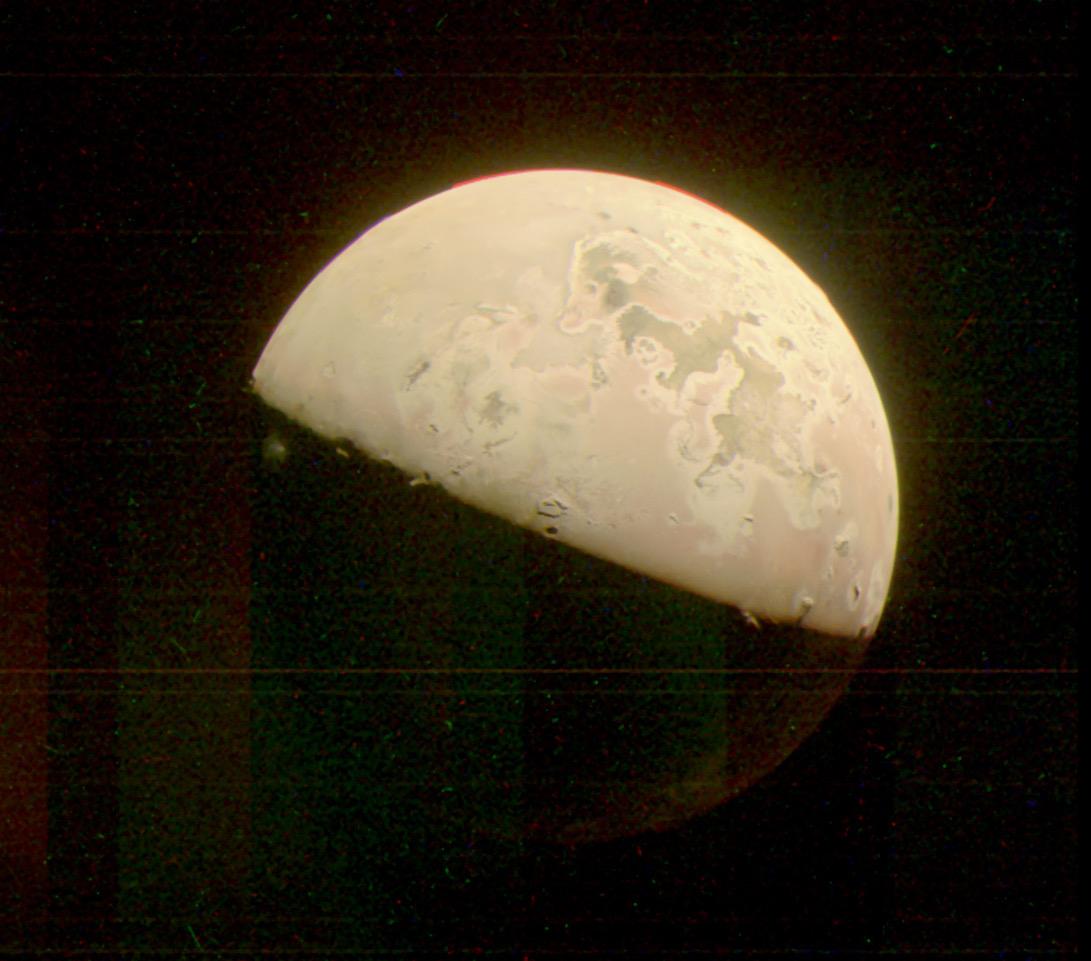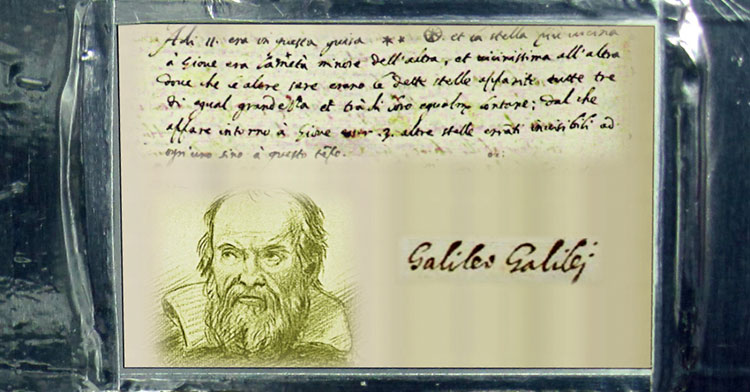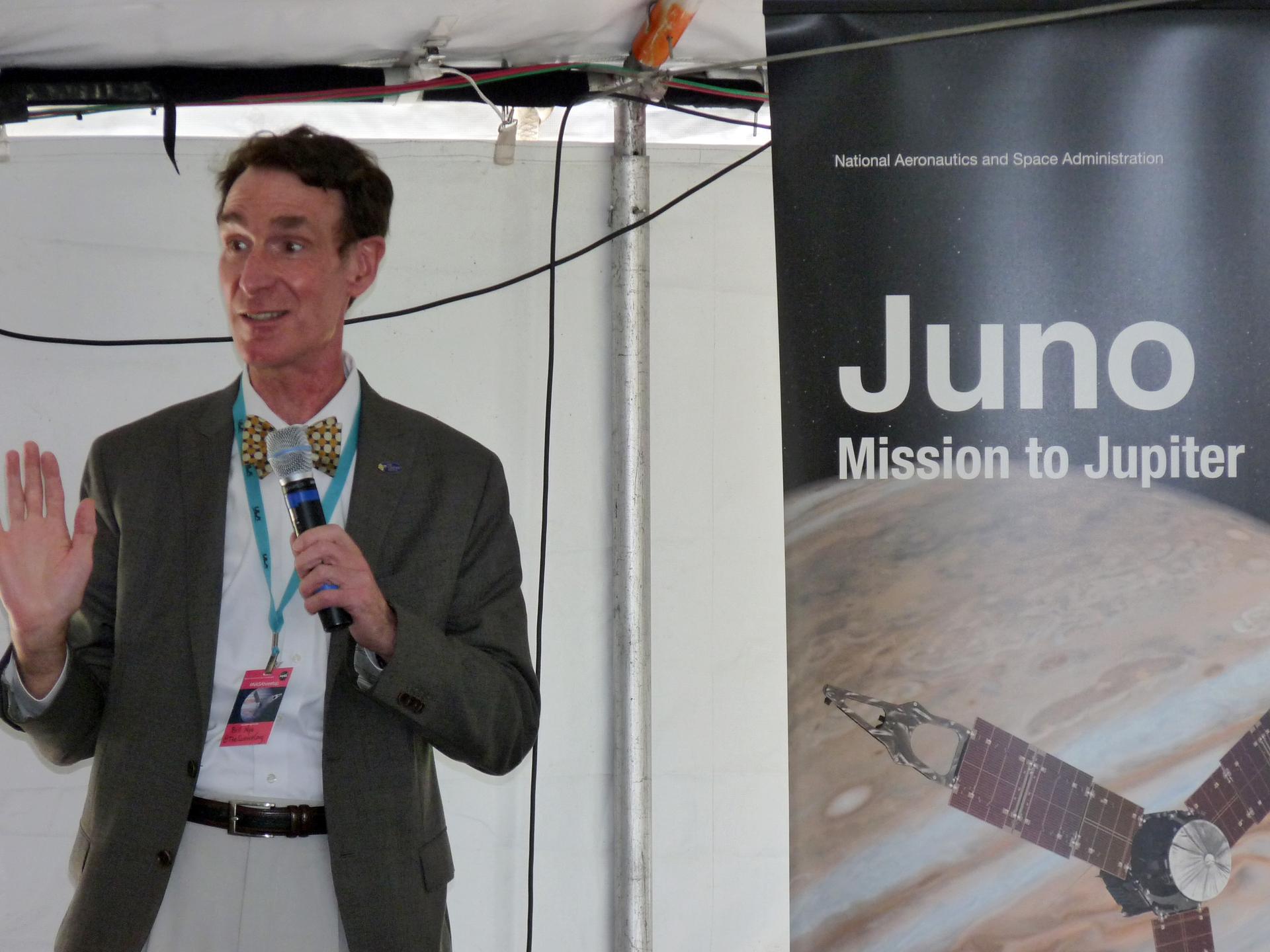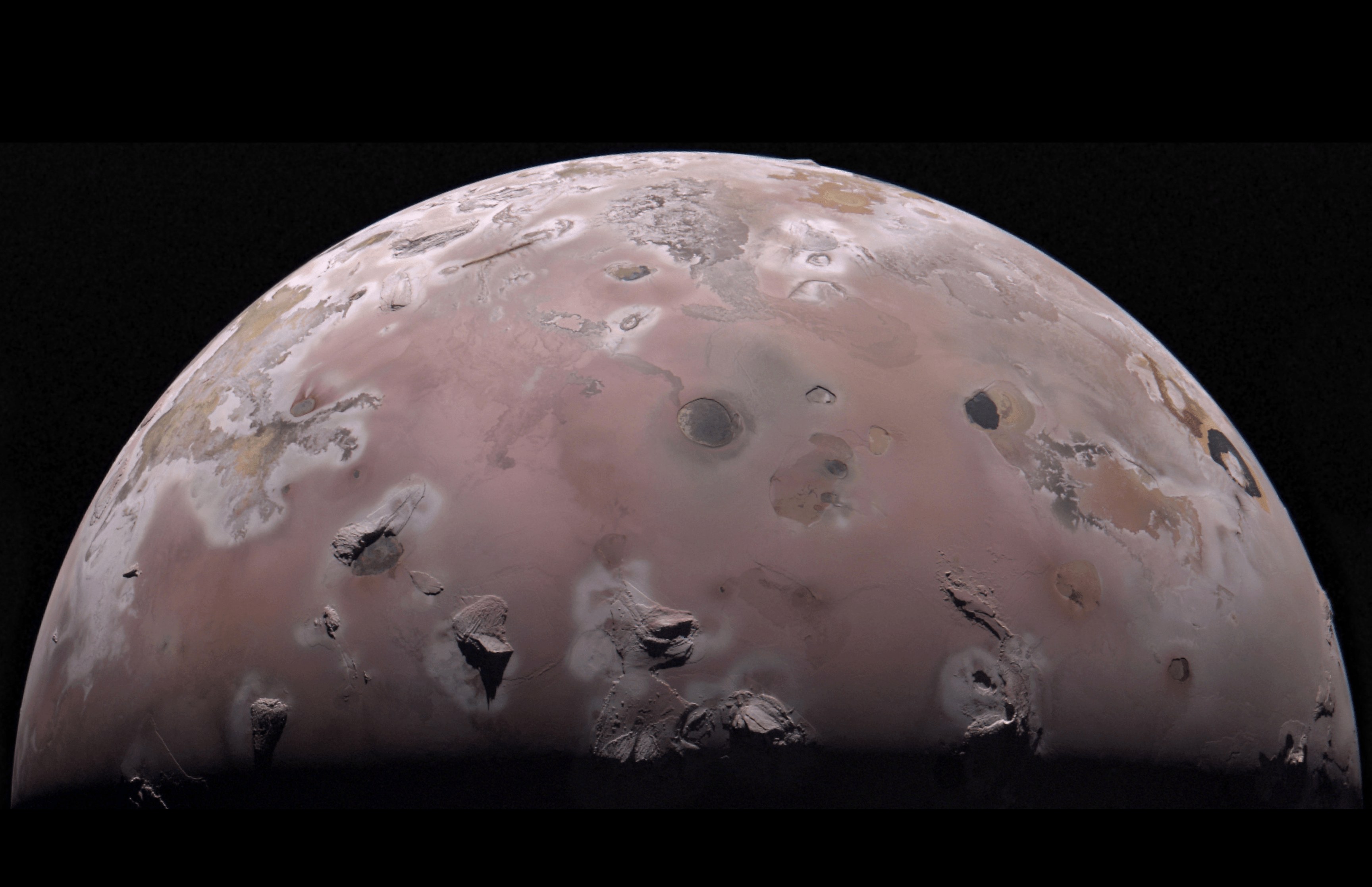Juno
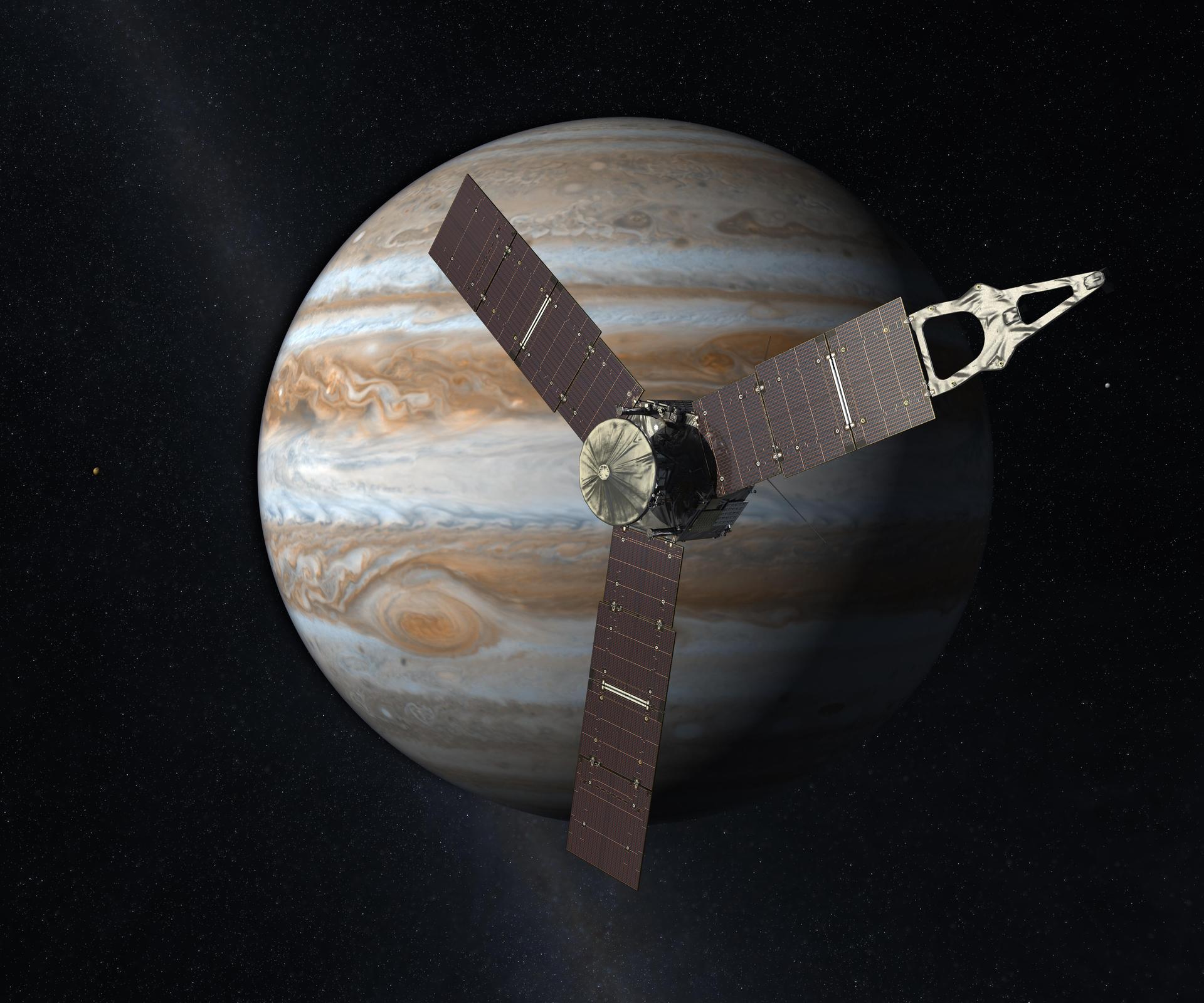
After enduring a five-year, 1.7 billion-mile journey from Earth, and evading showers of the most punishing radiation outside the Sun, Juno has provided breathtaking images and breakthrough discoveries from Jupiter and its moons. And in their quest to engage and inspire the public, the Juno mission team shares the pictures with the world, fueling citizen science and creative artistry.
From its very first orbit, stretching across 53 days from Jupiter’s cloud tops to the frontiers of its magnetic field, Juno has upended our views of the gas giant and its surroundings. The spacecraft found previously unseen networks of vast storms swirling around Jupiter’s poles, active volcanoes and lakes of lava on the tempestuous moon, Io, and answers to a decades-old question about winds on Jupiter extending hundreds of miles toward the planet’s interior. It’s scheduled to continue investigating the solar system’s largest planet through September 2025.
Jupiter is the Rosetta Stone of our solar system. Juno is going there as our emissary – to interpret what Jupiter has to say.

scott bolton
Juno's principal investigator, Southwest Research Institute in San Antonio
juno firsts
Overview
Jupiter, king of the gods in Roman mythology, was also god of the sky and storms; he once concealed himself in a veil of clouds to hide his misbehavior.
His wife, Juno, queen of the gods, noticed this sudden fog and grew suspicious; she swooped down from the heavens and broke through the haze to investigate. She could see Jupiter’s true nature.
Like its namesake, NASA’s Juno spacecraft – flying low across the clouds that encircle the planet – peers through storms and cyclones to unveil Jupiter’s secrets.
The mission’s many discoveries have changed our view of Jupiter’s atmosphere and interior, revolutionizing our understanding of the planet, and of the solar system’s formation.
'Steeple Mountain' and a Glass-Smooth Lake of Lava
Juno mission scientists transformed data from recent close passes of Io into animations highlighting a pair of dramatic features on the turbulent moon – a mountain piercing the sky like a cathedral spire, and a reflective lake of cooling lava dotted with islands. Juno cruised within about 930 miles (1,500 kilometers) of the surface during flybys of Io in December 2023 and February 2024.
Learn MoreMission Objectives
Juno's principal goal is to understand the origin and evolution of Jupiter. Underneath its dense cloud cover, Jupiter safeguards secrets to the fundamental processes and conditions that likely governed our solar system as it formed. Our primary example of a giant planet, Jupiter can also help us understand planetary systems being discovered around other stars.
Theories about solar-system formation all begin with the collapse of a giant cloud of gas and dust, or nebula, the bulk of which went into forming the infant Sun. Like the Sun, Jupiter is mostly hydrogen and helium, so it must have formed early, capturing most of the material left over after our star came to be. How this happened, however, is unclear.
Unlike Earth, Jupiter's giant mass allowed it to hold onto its original composition; like a time capsule, it provides us with a way to trace our solar system's history. Deciphering the origin and evolution of Jupiter will help us understand the formation of the rest of the solar system, including how Earth came to be, and how it became a haven for life.
Juno completed its primary mission by mid-2021, offering revelations about Jupiter’s interior structure, atmosphere (including polar cyclones, deep atmosphere, and auroras), and magnetosphere – the vast region around the planet influenced by Jupiter's uniquely intense magnetic field. Now Juno has pivoted to an extended mission, in which NASA’s most distant planetary orbiter expands on the discoveries it already made, while also exploring the full Jovian system. That includes the dust in the planet’s faint rings, and three of Jupiter’s four Galilean Moons – Ganymede, Europa, and Io – so named because in 1610 Italian astronomer Galileo Galilei was the first to identify the quartet of satellites (Callisto is the fourth – farther out than the other three, and not visited by Juno).
Jupiter's Moons
In January 1610, astronomer Galileo Galilei saw four points of light near Jupiter; but they didn't traverse the sky like other stars, they remained close to the planet. He realized he was seeing moons – the first discovered beyond Earth.
In June 2016 as it approached Jupiter, NASA's Juno spacecraft enjoyed the same orbital ballet that Galileo witnessed, and captured a unique time-lapse movie of the Galilean moons in motion around the planet. The movie begins on June 12, 2016, with Juno 10 million miles (16 million kilometers) from Jupiter, and ends on June 29, 3 million miles (5 million kilometers) distant. The innermost moon is volcanic Io; next in line is the ice-crusted ocean world Europa, followed by massive Ganymede, and finally, heavily cratered Callisto.
Spacecraft Design
With a distinctive silhouette, like a three-bladed fan spinning through space, the Juno orbiter would fill a basketball court. Its hexagonal main body measures about 11.5 feet high and wide (3.5 meters), and the “blades” – actually huge solar arrays – give it an overall width exceeding 66 feet (20 meters).
Juno’s rotation keeps it stable in flight – the way a spinning top or gyroscope remains steady – as the spacecraft spins twice per minute for science operations, which it increased to five rotations per minute when it performed main-engine maneuvers. Also, Juno’s instruments are all fixed, so the rotating spacecraft gives each of them regular turns at their targets during close passes over Jupiter, a trip that takes about two hours from pole to pole.
The instruments Juno carries in its toolbox:
- Microwave Radiometer (MWR): To measure the abundance of water and ammonia in the deep layers of Jupiter’s atmosphere, obtain a temperature profile of the atmosphere, and make surface and subsurface observations of Jupiter’s moons
- Jovian Infrared Auroral Mapper (JIRAM): A spectrometer to provide images of auroras in Jupiter’s upper atmosphere, and observations of the composition and temperature of the surface of Jupiter’s moons. This was a contribution of the Italian Space Agency (ASI)
- Magnetometer (MAG): To map Jupiter’s magnetic field and determine the dynamics of the planet’s interior, and map the magnetic field in the vicinity of Jupiter’s moons
- Gravity Science (GS): To map the distribution of mass inside Jupiter by measuring its effect on the spacecraft’s radio signals to and from Earth
- Jovian Auroral Distributions Experiment (JADE): To measure aspects of ions and electrons at low energy present in the auroras of Jupiter, and in the vicinity of Jupiter’s moons
- Jovian Energetic Particle Detector Instrument (JEDI): To measure aspects of ions and electrons at high energy present in the auroras of Jupiter, and in the vicinity of Jupiter’s moons
- Radio and Plasma Wave Sensor (Waves): To identify the regions of auroral currents that define Jovian radio emissions and acceleration of the auroral particles, and make similar observations around Jupiter’s moons
- Ultraviolet Spectrograph (UVS): To provide spectral images of the ultraviolet auroral emissions in the planet’s polar magnetosphere, as well as measure ultraviolet auroral emissions from Ganymede
- JunoCam: A visible-light camera/telescope to study the dynamics of Jupiter’s clouds and surface features of Jupiter’s moons, and to facilitate education and outreach
- Stellar Reference Unit (SRU): This engineering camera is used to help orient Juno in space by taking images of the stars, but has also been employed to take low-light images used to gather information on Jupiter’s radiation, atmosphere and lightning, dust rings, and the surfaces of Jupiter’s moons
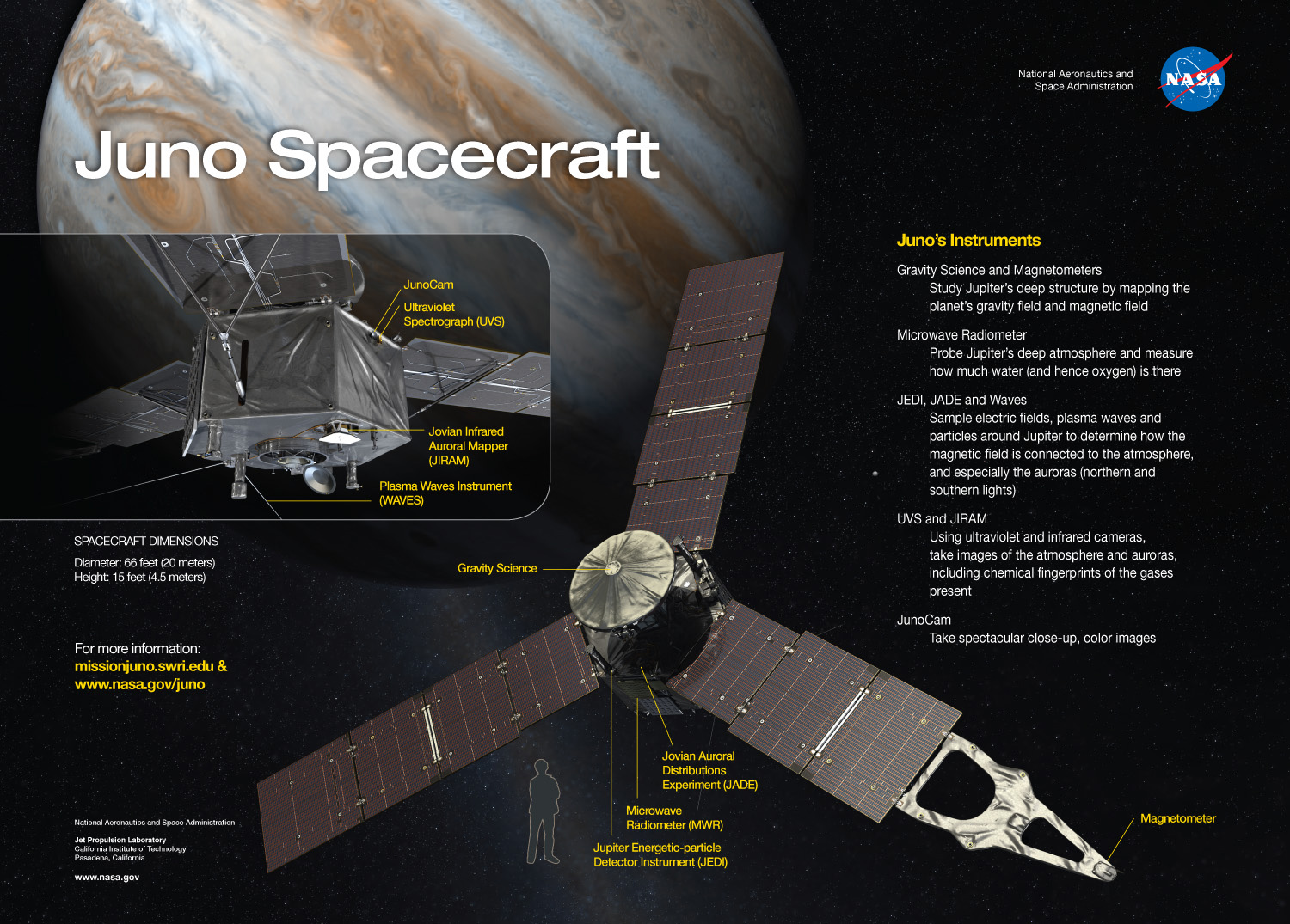
Solar Sailor
Juno is the first solar-powered spacecraft designed by NASA to operate at such a great distance from the Sun. Jupiter’s orbit is five times farther from the Sun than Earth’s, so the giant planet receives 4% as much sunlight as Earth does. To generate adequate power, Juno’s solar arrays needed to be quite large; each of its three solar arrays extend about 29.5 feet (9 meters) from the main body. But each expansive array was built as multiple hinged segments, so the panels could fold up before launch, and the spacecraft could fit into the payload fairing of its rocket.
With Juno pioneering the use of solar power at the outer planets, NASA’s next mission to Jupiter will carry even larger arrays. Europa Clipper, set to launch in October 2024, will be powered by twin solar arrays, each about 46.5 feet (14.2 meters) long and 13.5 feet (4.1 meters) wide. In total, its wingspan extends more than 100 feet (30.5 meters) – greater than the height of a 10-story building.
For many of Juno’s instruments to do their job, the spacecraft had to orbit closer to Jupiter than any previous mission. But the planet is surrounded by a powerful magnetic field that is 15 times more powerful than Earth's magnetic field, and in some places, more than 50 times more intense. It rotates with Jupiter and sweeps up charged particles, accelerating them to very high energies and creating intense radiation that bombards anything passing near the planet, including spacecraft.
To avoid the highest levels of radiation in the belts surrounding Jupiter, Juno flies in long, looping orbits that approach the gas giant from the north. Over the north pole it dives between the radiation belts and the planet, at times descending to 2,200 miles (3,500 kilometers) above the cloud tops. That might sound like a great height, but if Jupiter were the size of a basketball, the equivalent distance would be less than one-quarter of an inch (0.6 centimeters).
Juno traverses the planet and exits over the south pole, then zooms far away – beyond even the orbit of the Jovian moon Callisto – before Jupiter’s gravity pulls the spacecraft back for another pass.
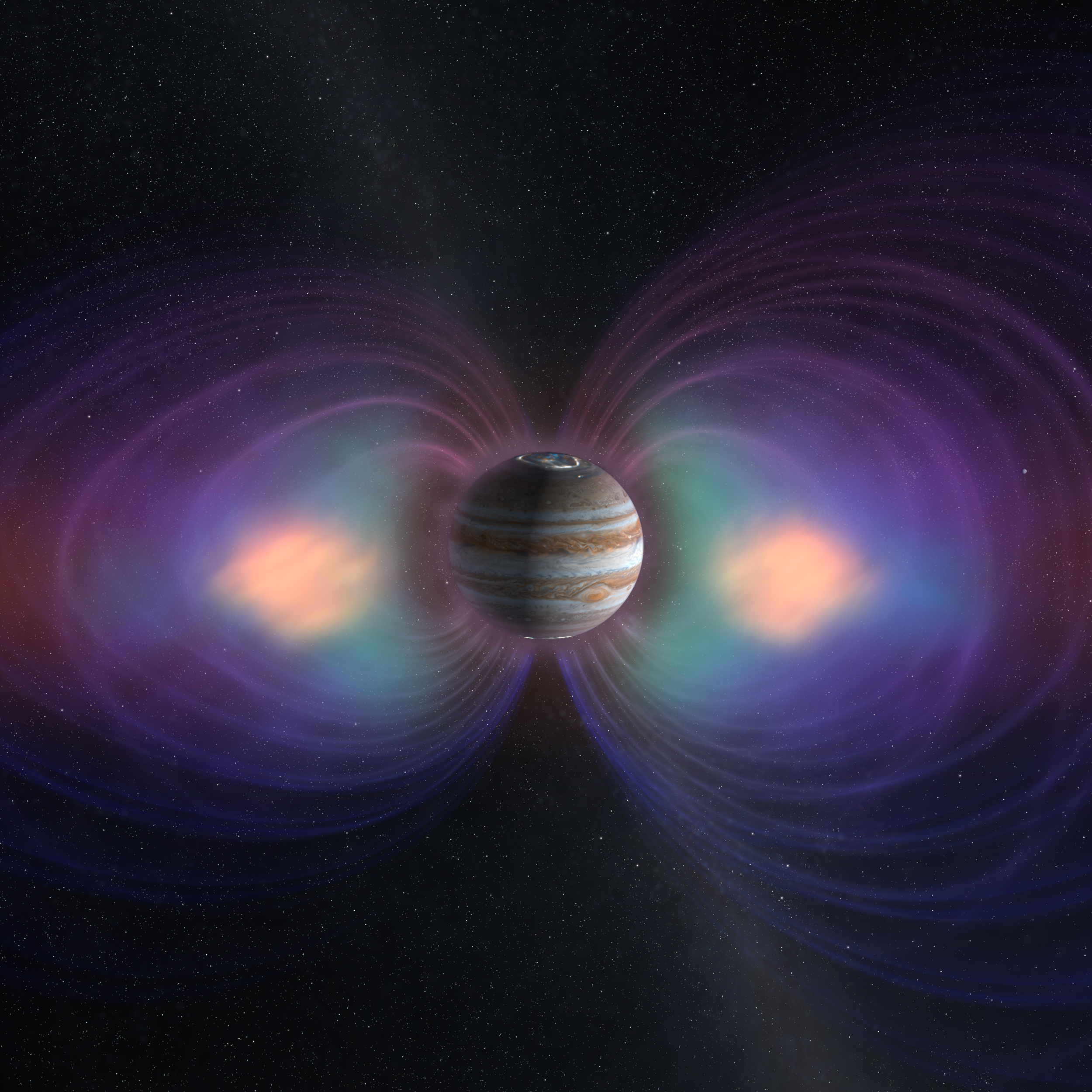
Armored Vault
To shield its delicate instruments from the planet’s merciless radiation belts, Juno carries a first-of-its-kind electronics vault. The titanium enclosure at the center of the spacecraft, about the size of an SUV’s trunk and weighing 400 pounds (180 kilograms), protects Juno’s sensitive electronics from the barrage of high-energy particles pummeling the spacecraft.
Among the tools Juno is carrying, JunoCam is especially noteworthy. In space exploration, where every ounce of weight, second of observation time, and byte of data transmitted is precious, this visible-light, color camera was included on the spacecraft explicitly to reach out to the public – whom the Juno science team is embracing, even deputizing.
Early in the mission, they invited amateur astronomers to weigh in, debate, and help plan where JunoCam should focus next. And they’ve encouraged researchers, photographers, artists, and anyone else to take Juno’s raw images to study, process, and play with them.
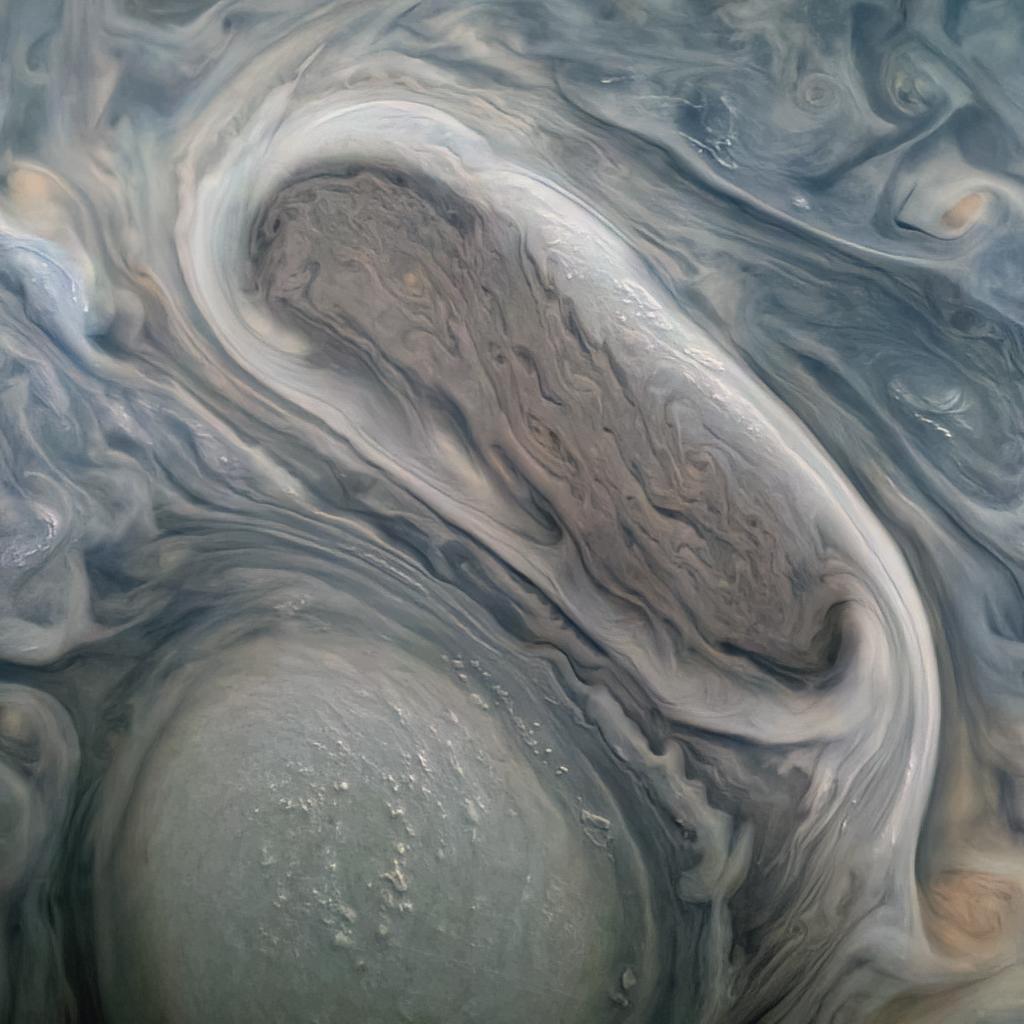
Some of the pictures – after citizen scientists adjusted color or contrast – revealed cloud heights and other features that were hard to distinguish in the muted raw images coming straight from the spacecraft. Another contributor stitched together images of individual cyclones near the north pole; the complete picture surprised researchers, showing a pinwheel of complementary storms twirling around a central vortex. Others had more whimsical takes on the JunoCam views, turning Jupiter’s swirls into artwork that echoes Monet or VanGogh, or adding dreamlike figures or stark geometrics.
Art+Science: A Sampler of Jupiter Images from JunoCam
JunoCam Images
Launch and Cruise Phases
Juno began its circuitous five-year journey to Jupiter on Aug. 5, 2011, launching from Cape Canaveral Air Force Station on Florida’s Atlantic coast.
With the four-ton probe and its wide solar arrays folded inside the nose, an Atlas V rocket thundered aloft at 12:25 p.m. EDT (26:25:00 UT) from Launch Complex 41 – the same pad where the Voyager and New Horizons spacecraft took flight, and where the Viking landers, and Curiosity and Perseverance rovers headed to Mars.
Juno, likewise, set a course away from Earth toward the outer planets. It crossed the orbit of Mars, but didn’t continue onto Jupiter quite yet. Mission designers used the Sun’s gravity and a pair of main engine burns in September 2012 to guide Juno back toward Earth – an essential detour.
Juno returned home 26 months after it left. But it didn’t stop.
It dashed toward Earth, pulled in by gravity, then sped away with greater energy than before. In this maneuver, called a gravity assist, Juno borrowed some momentum from Earth – which itself is hurtling through space around the Sun at 18 miles per second (29 kilometers per second). This slingshot effect boosted Juno’s velocity by 16,330 mph (about 7.3 kilometers per second), giving the spacecraft sufficient energy to climb away from the inner solar system and make it out to Jupiter.
Without the boost from gravity assist, Juno would have required a more powerful launch vehicle, or a more time-consuming voyage, to reach its destination.
Orbital Insertion
After a voyage of nearly five years and 1.7 billion miles (2.8 billion kilometers), Juno finally reached Jupiter and was scheduled to go into orbit on July 4, 2016.
Now the Juno team had to hit the brakes, to give Jupiter’s gravity field a chance to ensnare the craft and bring it into orbit. The spacecraft needed to fire its main engine at precisely the right time and place. Too soon, it wouldn’t have enough fuel for a second chance. Too late, and Juno would speed past the planet, ending the science mission before it even began.
During the Jupiter Orbit-Insertion phase, or JOI, the spacecraft had to complete an intricate series of critical steps on its own – turn away from the Sun, point in the correct direction relative to Jupiter, turn off unnecessary instruments that could interrupt the sequence, increase its rotation from 2 to 5 revolutions per minute (RPM) to help stabilize it, maintain communications with the enormous dish antennas of the Deep Space Network in Australia and California, and finally ignite the crucial 35-minute main-engine burn, to slow down Juno and guide it into orbit.
Mission operators designed the spacecraft’s configuration and commands so it could complete the entire sequence all on its own, even if some things didn’t go as planned, even if it had to reboot itself and start over. Because of the distance from Earth, messages to and from Juno took 48 minutes to arrive. There was no time for last-minute corrections to speed or attitude.
A tweet from NASA’s Juno Mission account at 11:54 p.m. EDT relayed the outcome: “Engine burn complete and orbit obtained. I’m ready to unlock all your secrets, #Jupiter. Deal with it.”
The Science Mission
Orbit insertion had gone flawlessly. After a five-year journey across billions of miles, the engine burn completed within one second of its predicted timing. Then Juno got to work.
From its very first data-collection pass on Aug. 27, 2016, Juno revealed Jupiter as a complex, gigantic, turbulent world – even more than scientists had predicted. Polar cyclones as large as Earth, plunging storm systems that travel deep into the heart of the gas giant, and a mammoth, lumpy magnetic field far more powerful than the strongest magnetic field found on Earth, all tantalized scientists.
Previous spacecraft visiting Jupiter traveled along a plane more or less even with its equator – the same view of the planet that’s visible from Earth. Juno was the first to fly over the north and south poles, a unique vantage point that accounts for many of the mission’s surprises.
Scientists discovered that the massive auroras undulating at Jupiter’s poles seem to form by different processes than the northern lights and southern lights on Earth. Investigators also discovered that lightning storms, which on Earth are more common near the equator, are a polar phenomenon on Jupiter, where they drop softball-sized hailstones of ammonia and water.
A technical concern arose early in the mission, however – it changed Juno’s timeline, and altered what it would accomplish during its time in orbit.
Originally, the flight plan had Juno looping around Jupiter for a couple of 53-day orbits, then shrinking those orbits to 14 days for the remainder of the mission – spending about 15 months circling and studying the planet. But a problem in the main engine, with some valves not working as expected, troubled the Juno team; a misfire could prove disastrous. They decided to maintain the status quo of the longer orbits.
Each flyby of Jupiter would give Juno’s instruments the same two-hour window to collect data, but they would come every seven weeks, instead of every two.
The new plan meant a much longer schedule to complete Juno’s science goals. Then again, the wider orbits would allow for “bonus science” that wasn’t part of the original mission design.
The spacecraft could further explore the far reaches of space dominated by Jupiter’s magnetic field. And after it completed its initial goals, and NASA extended the mission, the Juno team realized that the long orbits would evolve to eventually put the planet’s Galilean moons within reach.
On June 7, 2021, during orbit 34, Juno flew within 652 miles of Ganymede, Jupiter’s largest moon (in fact, the largest moon in the solar system). It was the closest such encounter since the Galileo spacecraft flew by Ganymede in May 2000.
Ganymede’s gravity altered Juno’s orbit, reducing its period from 53 days to 43 days and enabling a rendezvous with Europa in September 2022. That flyby further shrank Juno’s orbital period to 38 days, setting up encounters with Io in December 2023 and February 2024, which pushed Juno into its final orbital schedule, circling Jupiter every 33 days until end of mission.
When the spacecraft launched, its primary mission was scheduled to end in 2017, but NASA pushed that back to July 2021, to incorporate time needed for the longer orbits. When Juno completed those tasks, the spacecraft remained healthy and continued sending back astonishing data and breathtaking imagery, so NASA extended its stay to 2025.
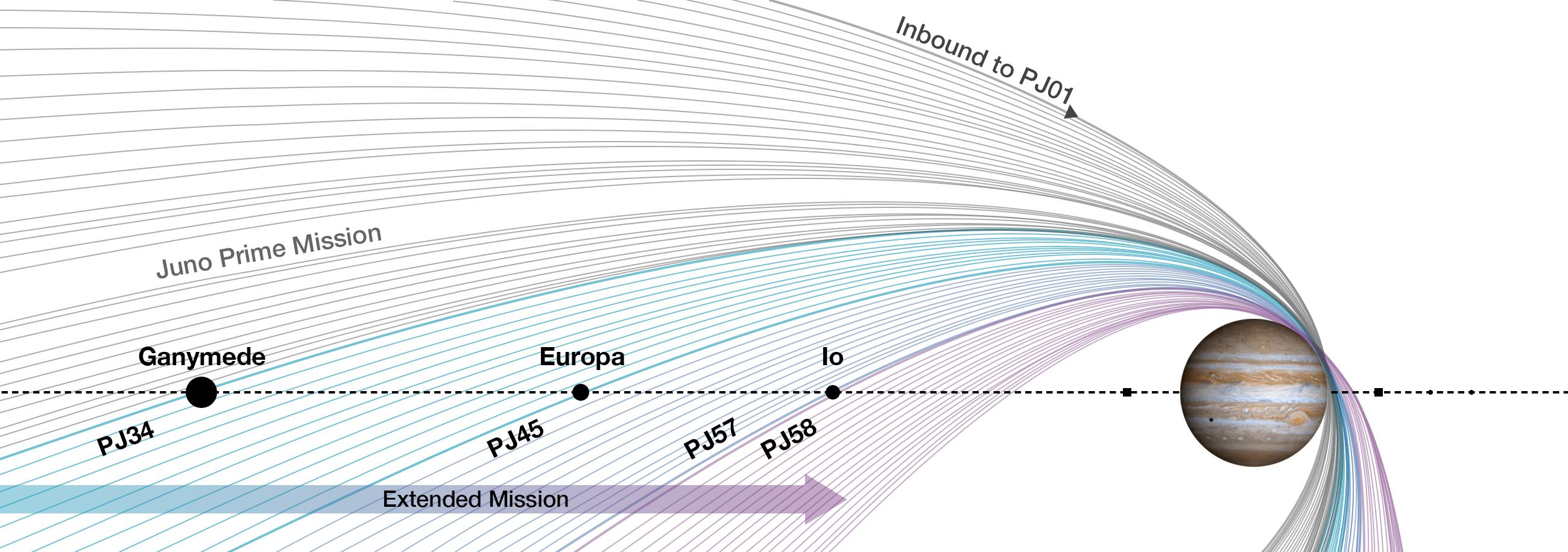
Scientific Discoveries and Results
The signature bands of multicolored clouds we see encircling Jupiter, called belts (the dark orange stripes) and zones (the light areas, in shades of gray), penetrate deep into the atmosphere. But how far? One of the most fundamental questions about the giant planet, scientists have debated that for decades. By measuring Jupiter’s gravity field, Juno discovered that the belts and zones – which are alternating east- and west-flowing jet streams – extend about 1,900 miles (3,000 kilometers) below the cloud tops.
Scientists long thought Jupiter had a small, solid core surrounded by all its hydrogen and helium. Juno data suggests the core is much larger than expected, yet partially dissolved, with no clear separation from the hydrogen swirling around it, leading researchers to describe the core as dilute, or “fuzzy.”
Under extreme pressure, gases can turn into their liquid form. Inside Jupiter the atmospheric pressure is so great, it compresses hydrogen gas not merely into liquid, but a fluid known as liquid metallic hydrogen. This exaggerated pressure makes the liquid hydrogen act like a metal conducting electricity, and scientists believe it’s the source of Jupiter’s uniquely intense magnetic field. Years of Juno measurements of Jupiter’s magnetic field point to that possibility, at a depth much shallower than expected.
Before Juno arrived, the largest planet in our solar system still had vast areas unexplored, unknown, even unseen. Among other discoveries Juno made possible:
- JunoCam provided the first clear, close-up pictures of Jupiter’s north pole – a strange, bluish region full of giant storms and strange weather.
- A central cyclone at the north pole is surrounded by eight more, as if they’re bowing in tribute. These cyclones stretch more than 2,500 miles across (4,000 kilometers). And though their spiral arms smack together as they spin, the storms don’t merge.
- During a close flyby of the south pole, Juno spotted a new, giant cyclone in the region. A pattern of six cyclones, with one in the center, had seemed locked in place at the south pole, but a new maelstrom had somehow muscled in.
- Scientists knew Jupiter had an intense magnetic field. Juno showed it’s far more intense than anyone expected – in some places more than 30 times as powerful as the one surrounding Earth.
- The now-departed Galileo spacecraft dropped a probe into Jupiter’s atmosphere in 1995 and found the place where it entered to be strangely dry, with one-tenth the water that scientists expected. Juno solved the mystery, showing that water is much more abundant nearer Jupiter’s equator.
- High-voltage electrical charges contribute to the formation of auroras at Jupiter’s poles, just as they do on Earth. But Jupiter is the solar system’s Texas: everything’s bigger. The most powerful energies there come to 400,000 electron volts, while our most powerful auroras on Earth hit only a few thousand volts.
- Maybe the most iconic storm in the solar system, Jupiter’s Great Red Spot has been swirling for centuries. But it appears to be slowly shrinking, from twice Earth’s size in 1979 to 1.3 times now. Juno plumbed the depths of this signature cyclone, showing that its roots run 200 miles (320 kilometers) deep — 50 to 100 times as deep as Earth’s oceans.
- Since April 2022, Juno has been observing the volcano-covered moon Io. and has sent back images that appear to show fresh lava fields, in areas last seen in visible-light images during Galileo and New Horizon flybys (in 1999 and 2007). The closest images of Io came from Juno’s passes in December 2023 and February 2024, but the monitoring will continue through the current end of the extended mission, scheduled in September 2025.
- Juno has spent years tracking the Great Blue Spot. Not to be confused with Jupiter’s iconic red storm, the Blue Spot is an invisible, localized, intense magnetic field on Jupiter’s equator. The spacecraft showed that the Blue Spot appears to be drifting eastward, pushed by winds measured at the surface; at its current course and speed, the spot could circumnavigate the planet in 350 years.
Every 53 days we go screaming by Jupiter, get doused by a fire hose of Jovian science, and there is always something new.

scott bolton
Juno's principal investigator, Southwest Research Institute in San Antonio
End of Mission
The Juno team originally expected the craft would make 33 orbits – enough passes to compile a full map of the planet – completing its science objectives by October 2017. They would then steer it into the planet, to burn up in the atmosphere.
In spite of all the mission team’s precautions while building and launching Juno, microbes from Earth could still have hitched a ride on the spacecraft, lying dormant, awaiting a new home. The self-destruct maneuver would have satisfied NASA’s planetary protection requirements, avoiding any chance Juno could crash into the Jovian moons Europa, Ganymede, or Callisto – ocean worlds, with Europa in particular considered a prime candidate in the search for life beyond Earth – and contaminate them with microscopic life from Earth.
The Cassini mission, orbiting Saturn from 2004 to 2017, prompted similar concerns – protecting the integrity of Saturn’s moons Enceladus and Titan, also believed to contain possibly habitable environments. As a grand finale, the mission team plunged Cassini through the rings and into Saturn, collecting science until the end.
The same fate befell NASA’s Galileo orbiter – Juno’s predecessor to Jupiter from 1995-2003, and the mission that discovered the possibility of a subsurface ocean on Europa. That hardy spacecraft endured more than four times its designed radiation exposure, but was running out of fuel when placed on a collision course with Jupiter in September 2003. The possibility of life existing on Europa compelled protection for that icy moon, as well as plans for future investigations.
With Juno, however, the evolution of its flight path in the extended mission meant that it no longer posed a risk to contaminate these ocean worlds, now beyond its reach. The spacecraft will continue its exploration of Jupiter, its ring system, and moons through September 2025. Then Juno’s orbit will degrade naturally, and Jupiter’s gravity will pull the spacecraft in to be consumed in the atmosphere.
Legacy and Impact
In its extended mission, NASA’s most distant planetary orbiter continues its investigation of the solar system’s largest planet. And Juno’s work continues building on the discoveries of previous missions that visited Jupiter – Pioneer 10 and 11, and Voyager 1 and 2 in the 1970s, then the Galileo orbiter and its atmospheric probe, as well as those spacecraft who made key observations while en route to other targets (Ulysses, Cassini, and New Horizons).
In turn, Juno is also preparing the way for future visitors, such as ESA’s Juice mission (JUpiter ICy moons Explorer), launched in April 2023 and scheduled to reach Jupiter in July 2031. Next to go, NASA’s Europa Clipper is scheduled to launch in October 2024, and enter orbit around Jupiter in April 2030.
For Juno, exploring the full Jovian system, passing through the doughnut-shaped clouds of charged particles surrounding Europa, Io, and the other moons, testing the radiation environment, studying the dust in Jupiter’s faint rings – all this work and more will inform the mission designs, science priorities, observation strategies, and more for Europa Clipper, Juice, and others that will surely follow.
Jupiter Exploration
Juno continues a lineage of discovery at the king of planets, and is helping prepare the next generation of missions bound for Jupiter.
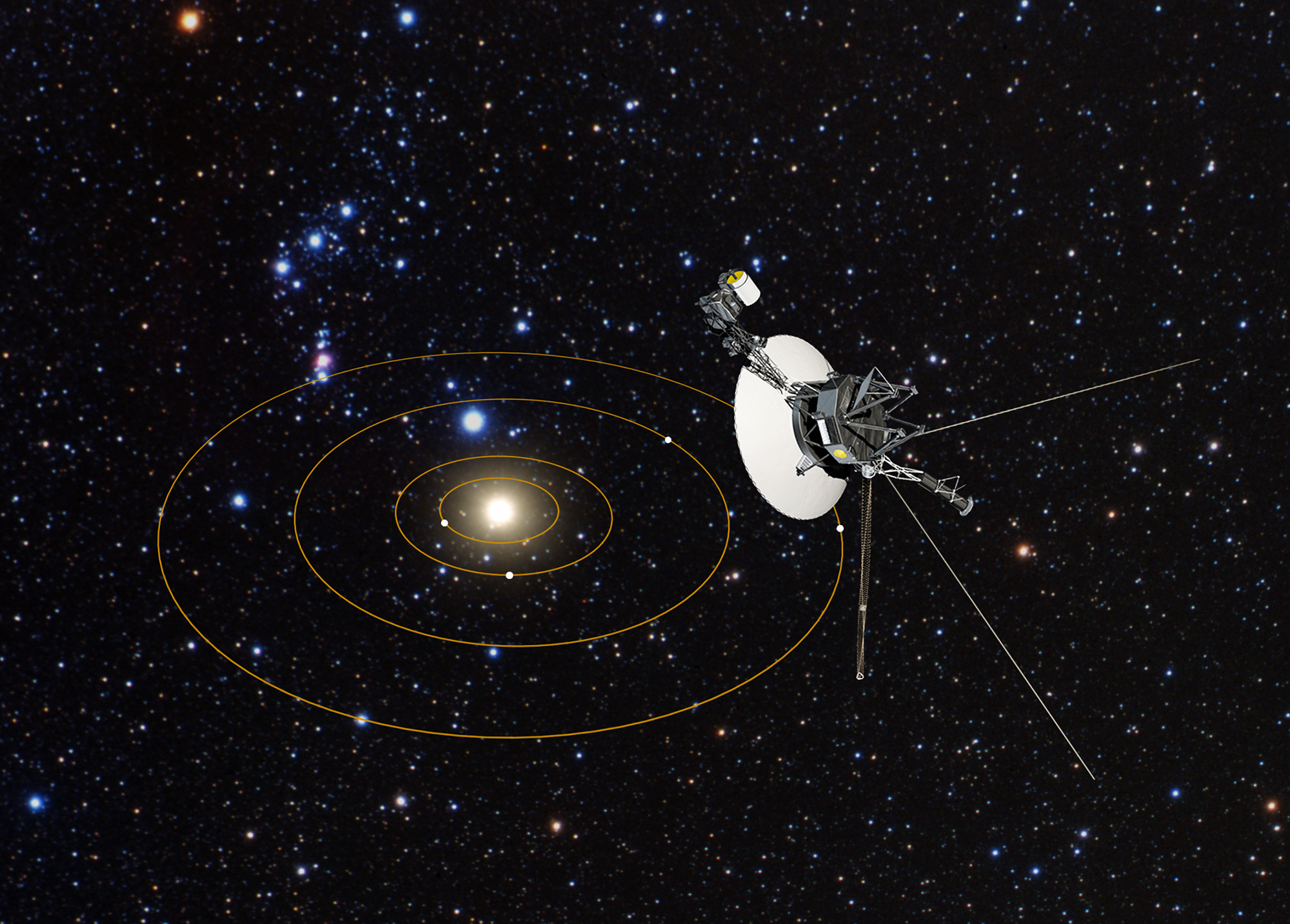
Continuing a Legacy
Juno builds on the work of previous missions to Jupiter, and paves the way for missions yet to come.

Europa Clipper
Scheduled to reach Jupiter's moon Europa in 2030, this NASA mission will search beneath Europa's icy surface for signs of life.

Juice
Juice, the JUpiter ICy moons Explorer from the European Space Agency, will study the gas giant and its three large ocean-bearing moons – Ganymede, Callisto, and Europa – after arriving in 2031.
jan. 7, 1610
'Around Jupiter there are... moving stars, invisible till this time to everyone.'
A plaque dedicated to Rennaissance astronomer Galileo Galilei is seen here mounted on NASA's Juno spacecraft for its trip to Jupiter. The aluminum plaque features a self-portrait and handwritten text from Galileo's journal, in which he records seeing Jupiter's moons for the first time.
Credits: NASA/JPL-Caltech/KSC
Juno and Pop Culture
Images from JunoCam – the dazzling views of Jupiter and its satellites, whether processed by amateur astronomers or artists – have sharpened our perspective of the giant planet, and blurred the divide between art and science. It’s just one way Juno has bridged disparate worlds.
The mission inspired a partnership with Apple Music, which released a short film ahead of Jupiter Orbit Insertion. “Visions of Harmony: Inspired by NASA’s Mission Juno” featured a soundtrack composed by Academy Award winners Trent Reznor and Atticus Ross. At the same time, Apple released the compilation “Destination: Juno” with music tracks celebrating the mission, from artists including country star Brad Paisley, singer-songwriter Corinne Bailey Rae, rapper GZA of Wu Tang Clan, singer-songwriter QUIÑ, alternative band Weezer, and Mexican rock band Zoé.
To mark Juno’s 50th orbit around Jupiter on April 8, 2023, the Juno team released a collage of 50 images spanning various aspects of the mission, and NASA paired with Google Arts and Culture to show off a gallery of images and video from the project.
NASA has released several animations of JunoCam images, replicating the flight of Juno as it collected those shots, set to the music of Greek composer Vangelis (A "Flight" Over Jupiter - Mission Juno). The keyboardist won an Academy Award for his avant-garde “Chariots of Fire” film score in 1981, but the year before that he gained attention when Carl Sagan used his tune “Heaven and Hell” as a theme for “Cosmos: A Personal Voyage.” Vangelis’ 23rd and final studio album, released a few months before he died in 2022, was “Juno to Jupiter.”
Image data: NASA/JPL-Caltech/SwRI/MSSS
Image processing: Kevin M. Gill © CC BY
Music: Vangelis
The Juno mission also tasked science educator Bill Nye with bringing technical details of the project down to Earth, in the video series “Why with Nye: The Cool Stuff You Need to Learn About NASA’s Mission to Jupiter.”
Aboard the spacecraft itself, in addition to scientific instruments, Juno is carrying items of historical and educational significance. The Italian Space Agency provided a plaque depicting astronomer Galileo Galilei and handwritten text copied from his journal. In the January 1610 entry, he described what would later be known as the Galilean moons, Jupiter’s largest satellites – Io, Europa, Ganymede, and Callisto. Using a telescope he fashioned, Galileo spotted three points of light (and later a fourth) that stayed close to Jupiter, but didn’t move like the other stars. “It is evident that around Jupiter there are three moving stars invisible till this time to everyone,” he wrote. After a week of observation, Galileo realized they were moons – the first discovered beyond Earth.
Also secured to the spacecraft, as part of a joint outreach program between NASA and the LEGO Group, Juno carries a set of three LEGO mini-figurines. Crafted in aluminum and shielded under a thermal blanket, they represent Galileo, who is carrying a telescope, the Roman god Jupiter (wielding a lightning bolt), and the goddess Juno, his wife (holding a magnifying glass, ready to investigate).
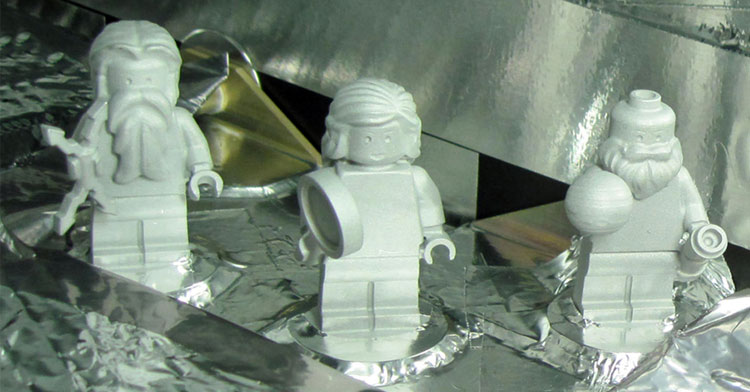
FAQs and More About the Mission
NASA’s Jet Propulsion Laboratory, a division of Caltech in Pasadena, California, manages the Juno mission for the principal investigator, Scott J. Bolton of Southwest Research Institute in San Antonio. Juno is part of NASA’s New Frontiers Program, which is managed at NASA’s Marshall Space Flight Center in Huntsville, Alabama, for the agency’s Science Mission Directorate in Washington. Lockheed Martin Space in Denver built and operates the spacecraft.
Frequently Asked Questions |
|---|
Q: What is the Juno mission? A: Juno is a solar-powered spacecraft sent to Jupiter – the first and largest planet in our solar system – to learn how it formed, and by extension how the solar system formed. |
Q: When was Juno launched and when did it arrive at Jupiter? A: Juno launched from Cape Canaveral, Florida, on Aug. 5, 2011, and went into orbit around Jupiter nearly five years later, on July 4, 2016. |
Q: What are the main objectives of the Juno mission? A: The spacecraft is investigating the origin and evolution of Jupiter, looking for its planetary core, mapping its magnetic field, measuring water and ammonia in the deep atmosphere, observing auroras, and studying Jupiter’s moons and dust rings, among other things. |
Q: What instruments does Juno carry, and what are they used for? A: Juno carries instruments to measure Jupiter’s electric and magnetic fields, particles, and plasma waves, and record the planet’s clouds, rings, aurora, and satellites in low-light, visible light, ultra-violet light, and infra-red light. In addition, Juno’s radio signal is used to measure Jupiter’s gravity field and upper atmosphere, and those of three of Jupiter’s four Galilean satellites. |
Q: What significant discoveries has Juno made? A: Juno is shedding light on Jupiter’s internal structure, showing that bands in the planet’s colorful, turbulent atmosphere descend far below the cloud tops, and that its mammoth magnetic field is even larger and more powerful than predicted. It has also revealed the size of Jupiter’s core, and helped scientists understand the amount of oxygen in the planet’s chemical makeup, which previously was a key missing ingredient for helping explain how the planet formed. |
Q: How long will the Juno mission last? A: The Juno mission, originally slated to explore Jupiter from 2016-2017, was extended by NASA, and is now scheduled to end in September 2025. |
Q: What will happen to Juno at the end of the mission? A: When Juno’s work is done, its trajectory will eventually degrade and the spacecraft will naturally burn up in Jupiter's atmosphere. Changes in Juno's orbit during its extended mission meant the spacecraft was no longer a threat to crash into and accidentally contaminate Jupiter’s possibly habitable moons. |
Q: How has Juno impacted our understanding of Jupiter and the solar system? A: As Juno reveals fundamentals of Jupiter – what’s in its core, how did it form, how much water does the giant planet hold – it helps us understand how the entire solar system coalesced, and how Earth formed and fostered life. |
Q: What is the legacy of the Juno mission? A: Juno is expanding our understanding of Jupiter and its system of moons and rings, and laying groundwork for follow-up missions to discover even more. Beyond that, with Jupiter as the archetype of a giant planet here in our solar system, research findings there have powerfully enhanced our understanding of giant planets across the galaxy. |
Q: Where can I find more information about the Juno mission? A: Learn more at Southwest Research Institute's Mission Juno website. |
Latest Juno News
Juno's Io Encounters
Consecutive flybys of Jupiter's moon Io – the most volcanic world in our solar system – offered the nearest view since the Galileo orbiter visited in 2001.
Juno had monitored Io from afar since the spacecraft arrived at Jupiter in 2016. Then, as part of its 57th and 58th orbits around the giant planet, Juno came within roughly 930 miles (1,500 kilometers) of Io's surface – less than the distance between Los Angeles and Seattle. The close passes, on Dec. 30, 2023, and Feb. 3, 2024, allowed scientists to compare data and images from these visits with previous observations that Juno and other craft made of this volatile world, slightly larger than Earth's Moon. Io is caught in a tug-of-war between Jupiter's powerful gravity and the smaller pull from two neighboring moons, churning its insides and creating eruptions and lakes of lava that cover its surface. Meanwhile, the gravitational pull Io exerted on Juno during the Feb. 3 flyby has reduced the spacecraft’s orbit around Jupiter to 33 days. It originally had been circling Jupiter and its environs in 53-day orbits, after it arrived at the king of planets on July 4, 2016.
More About the February 2024 Flyby
Jupiter's Volatile Moon, Io
The turbulent world is dotted with hundreds of volcanoes, some erupting so powerfully they're visible with large telescopes on Earth
The moon – one of four that astronomer Galileo Galilei discovered to be orbiting Jupiter in 1610 – is caught in a gravitational tug-of-war between its sibling moons, Europa and Ganymede, and the massive Jupiter. This creates tremendous tidal forces, like ocean tides on Earth, but which cause Io's solid surface to bulge up and down (or in and out) by as much as 330 feet (100 meters).
Read More About Io
Image processing by Alain Mirón Velázquez © CC BY


